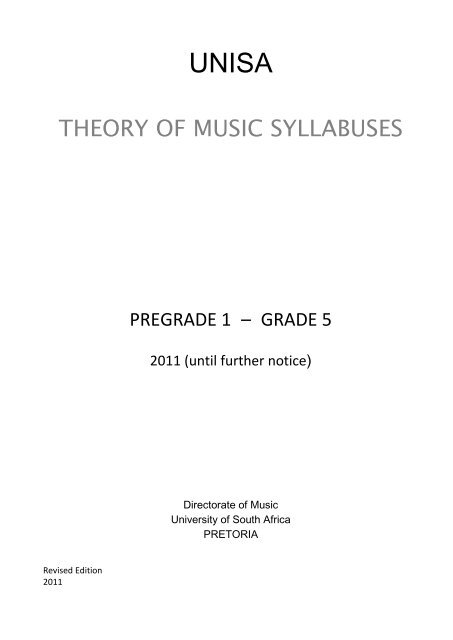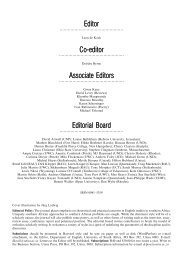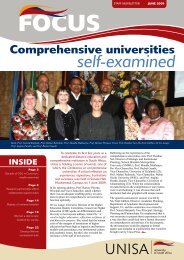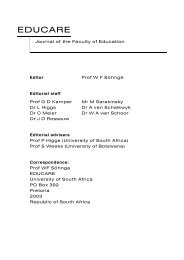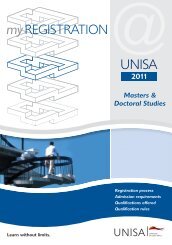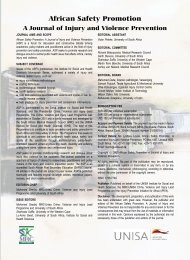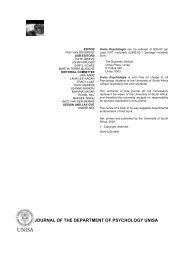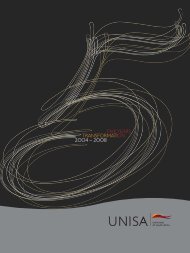THEORY OF MUSIC SYLLABUSES - Unisa
THEORY OF MUSIC SYLLABUSES - Unisa
THEORY OF MUSIC SYLLABUSES - Unisa
You also want an ePaper? Increase the reach of your titles
YUMPU automatically turns print PDFs into web optimized ePapers that Google loves.
UNISA<br />
<strong>THEORY</strong> <strong>OF</strong> <strong>MUSIC</strong> <strong>SYLLABUSES</strong><br />
Revised Edition<br />
2011<br />
PREGRADE 1 – GRADE 5<br />
2011 (until further notice)<br />
Directorate of Music<br />
University of South Africa<br />
PRETORIA
© Copyright © 2011 by <strong>Unisa</strong><br />
All rights reserved<br />
Printed and published by the<br />
University of South Africa<br />
Muckleneuk, Pretoria<br />
(ii)
CONTENTS<br />
GENERAL<br />
(iii)<br />
Page<br />
A Language medium (iv)<br />
B Examination periods (iv)<br />
C Stationery for theory examinations (iv)<br />
D Re-marking, Report of Marks and Examiner's Report (iv)<br />
NOTES REGARDING SOLFA NOTATION: Pregrade 1 – Grade 3 (v)<br />
PREGRADE 1 1<br />
GRADE 1 4<br />
GRADE 2 9<br />
GRADE 3 14<br />
GRADE 4 20<br />
GRADE 5 26
GENERAL<br />
A Language medium<br />
(iv)<br />
Theory of Music syllabuses and question papers are drawn up in English and<br />
Afrikaans. Syllabuses and question papers for the initial grades are also available in<br />
Sotho, Zulu and Xhosa.<br />
B Examination periods<br />
First examination period: The first week in June – Pregrade 1 to Grade 6.<br />
Second examination period: The first half of October – Pregrade 1 to Teacher's<br />
Licentiate.<br />
The precise dates will be fixed from year to year according to the number of entries,<br />
and the persons concerned will be notified about them in good time.<br />
C Stationery for theory examinations<br />
The University provides manuscript paper on which candidates may do rough work<br />
before writing their final answers on the examination paper.<br />
Pencilled answers will be accepted, provided they are clear and legible as, for<br />
example, when a B or HB pencil is used.<br />
D Re-marking, Report of Marks and Examiner's Report<br />
D.1 Re-marking of scripts<br />
The script of candidates who failed a theory examination can be remarked on<br />
payment of a fee equal to 50% of the entry fee for the examination in question. This<br />
fee is not refundable.<br />
D.2 Issuing of report of marks<br />
A report indicating the marks obtained by a candidate for individual questions in the<br />
theory examination may be issued on payment of the prescribed fee.<br />
D.3 Issuing of examiner's report<br />
An examiner's report on a candidate's theory examination may be requested at a<br />
fee equal to the full entry fee for the examination in question.<br />
In all cases referred to in D.1, D.2 and D.3, the application, together with the<br />
prescribed fee, should reach the University by 20 August (for the first session)<br />
and 20 January (for the second session of the previous calendar year). After<br />
these two dates the examination scripts are destroyed.
NOTES REGARDING SOLFA NOTATION:<br />
PREGRADE 1 – GRADE 3<br />
A PITCH<br />
(v)<br />
• Seven solfa syllables are used to indicate pitch. These syllables are<br />
abbreviated in a score and small letters are used to indicate them. The letters<br />
are written on one level:<br />
d r m f s l t (d 1 )<br />
• In solfa notation the key (key note / tonic) is indicated at the beginning of a<br />
piece:<br />
* In South Africa the moveable doh, instead of the fixed doh is used. The doh<br />
could be on any pitch.<br />
• To distinguish between the different register placements of a specific solfa<br />
syllable a number or comma is used as a:<br />
superscript: d 1 of d’ to indicate a higher pitch (an octave higher)<br />
subscript: d1 of d, to indicate a lower pitch (an octave lower)<br />
Examples<br />
Doh is C*<br />
Solfa notation<br />
Doh is C: d r m f s l t d 1<br />
Staff notation<br />
Solfa notation<br />
Doh is G: d r m f s l t d 1<br />
Staff notation<br />
Doh is G*
B TIME SIGNATURES AND NOTE VALUES (DURATION)<br />
(vi)<br />
• Barlines are indicated by vertical lines:<br />
Solfa notation Staff notation<br />
| | |<br />
• Beats (the main division of the bar) are divided by a colon ( : ) :<br />
Time signatures in Solfa notation Staff notation<br />
| : |<br />
| : : |<br />
| : ** | * : ** |<br />
* a shorter vertical line divides the bar into two halves<br />
** a colon divides the two halves into quarters<br />
• Subdivision of crotchet beats is divided by full stops ( . ) :<br />
Solfa notation Staff notation<br />
| . : . |<br />
| . : . : . |<br />
| . : . | . : . |
• Held, tied and dotted values:<br />
(vii)<br />
Minims and dotted minims are indicated by a dash ( – )<br />
Solfa notation Staff notation<br />
Doh is C<br />
| d : – |<br />
| d : – : d |<br />
| d : – : – |<br />
| d : – | d : – |<br />
| d : – | – : d |<br />
| d 1 : d 1 | – : d 1 |<br />
| d 1 : – : d 1 | – : d 1 : d 1 |<br />
| d 1 : – | – : d 1 | – : d 1 | d 1 : – |<br />
C major
• Rests:<br />
(viii)<br />
Rests are indicated by a blank/empty space<br />
Solfa notation Staff notation<br />
Crotchet rest<br />
Doh is G<br />
| d : | s : |<br />
| m : : r | d : – : |<br />
| d 1 : | m : r | d : – | – : |<br />
Minim rest<br />
Doh is C<br />
| d 1 : – | t : – | d 1 : – | : |<br />
Quaver rest<br />
Doh is G<br />
| m . : r . | d . : . |<br />
| d . : m . | s : | d 1 : – | d 1 : – |<br />
G major<br />
C major<br />
G major
EXAMPLE:<br />
Question – (Grade 3)<br />
Notate the following two-bar phrase from solfa notation to staff notation.<br />
Doh is G<br />
| d : r . m | d : m . s | d 1 : m . r | d : – |<br />
Answer<br />
(ix)
PREGRADE 1 [TV1–S]<br />
1<br />
• Number of examination papers : 1<br />
• Duration : 1 hour<br />
• Maximum marks : 100<br />
Roll of Honour : 95<br />
Distinction : 80<br />
Merit : 70<br />
Pass : 50
Pregrade 1<br />
SYLLABUS<br />
1 CLEFS AND COMPASS<br />
1.1 Clefs<br />
G clef (treble clef) and F clef (bass clef)<br />
2<br />
1.2 Compass in which written notes are to be recognised and used<br />
2 NOTE VALUES AND RESTS<br />
Note values: <br />
Rests:<br />
3 TIME SIGNATURES AND GROUPING<br />
3.1 Simple time signatures<br />
3.2 Grouping<br />
Correct grouping of prescribed note values and rests in prescribed time signatures<br />
(syncopation excluded).<br />
4 KEY SIGNATURES, SCALES AND TONE DEGREES<br />
4.1 Key signatures<br />
The writing and identification of the key signatures of C, G and F major in both<br />
clefs.
4.2 Scales<br />
3<br />
Pregrade 1<br />
The writing and identification of C, G and F major scales, without key signature, in<br />
semibreves, ascending from the tonic, in both clefs. Semitones to be indicated by<br />
slurs. Compass one octave.<br />
4.3 Tone degrees<br />
5 INTERVALS<br />
The writing and identification of the tonic, subdominant and dominant degrees of<br />
the prescribed scales, without key signature in both clefs. Technical names to be<br />
used.<br />
The writing and identification of a third and a fifth interval above the tonic of the<br />
prescribed scales in both clefs.<br />
6 TERMS AND SIGNS<br />
The meaning and application of:<br />
6.1 Dynamics<br />
forte, f (I)*; mezzo forte, mf (I); mezzo piano, mp (I); piano, p (I); crescendo,<br />
cresc. (I); decrescendo, decresc. (I); diminuendo, dim. or dimin. (I)<br />
6.2 Tempo<br />
allegro (I); allegretto (I); andante (I); moderato (I); ritardando, rit. or ritard. (I).<br />
6.3 Articulation<br />
legato (I); staccato, stacc. (I)<br />
6.4 Sign<br />
7 SOLFA NOTATION<br />
Names of the seven basic solfa syllables and abbreviations thereof:<br />
Solfa syllables<br />
doh ray mi fah soh lah ti (doh)<br />
Abbreviations<br />
d r m f s l t (d)<br />
_____________________<br />
* I = Italian
GRADE 1 [T10–8]<br />
4<br />
• Number of examination papers : 1<br />
• Duration : 1 hour<br />
• Maximum marks : 100<br />
Roll of Honour : 95<br />
Distinction : 80<br />
Merit : 70<br />
Pass : 50<br />
Syllabuses for Theory of Music Pregrade 1 up to and including Grade 8<br />
are accumulative, ie candidates should be familiar with the content of<br />
syllabuses of all previous grades.
SYLLABUS<br />
1 CLEFS AND COMPASS<br />
1.1 Clefs<br />
G clef (treble clef) and F clef (bass clef)<br />
5<br />
1.2 Compass in which written notes are to be recognised and used<br />
2 NOTE VALUES AND RESTS<br />
Note values: <br />
Rests:<br />
3 TIME SIGNATURES AND GROUPING<br />
3.1 Simple time signatures<br />
3.2 Grouping<br />
Grade 1<br />
Correct grouping of prescribed note values and rests in above-mentioned time<br />
signatures (syncopation excluded).<br />
4 KEY SIGNATURES, SCALES AND TONE DEGREES<br />
4.1 Key signatures<br />
The writing and identification of major key signatures up to and including two<br />
sharps and two flats, and the tonic minor of A major, ie a minor.
Grade 1<br />
4.2 Scales<br />
6<br />
The writing and identification of major scales up to and including two sharps and<br />
two flats, and the tonic harmonic minor of A major, ie a harmonic minor with as<br />
well as without key signature, in semibreves, ascending and/or descending from<br />
the tonic, in both clefs. Semitones to be indicated by slurs. Compass one octave.<br />
4.3 Tone degrees<br />
5 INTERVALS<br />
The writing and identification of the tonic, subdominant and dominant degrees of<br />
the prescribed scales, with as well as without key signature, in both clefs.<br />
Technical names to be used.<br />
The writing and identification of a third and a fifth, above the tonic of the prescribed<br />
keys, with as well as without key signature, in both clefs.<br />
6 TRIADS<br />
The writing and identification* (figuring/chord symbols) of the tonic (I/i), subdominant<br />
(IV/iv) and dominant triad (V) (primary triads) of the prescribed keys in root position and<br />
in close structure, with as well as without key signature, in both clefs.<br />
Examples: three-part in close structure on one stave.<br />
Major keys Major keys<br />
without key signature with key signature<br />
Minor keys<br />
with and without key signature<br />
_____________________<br />
* Figure triads with Roman numerals: D: I; a: i<br />
** Major keys are indicated by capital letters and minor keys by small letters.
7 TERMS AND SIGNS<br />
The meaning and application of:<br />
7.1 Dynamics<br />
fortissimo, ff (I)*; pianissimo, pp (I);<br />
7.2 Tempo<br />
7<br />
Grade 1<br />
adagio (I); andantino (I); presto (I); rallentando, rall. (I); ritenuto, (I);<br />
accelerando, accel. (I); a tempo (I)<br />
7.3 Character<br />
cantabile (I); semplice (I)<br />
7.4 Articulation<br />
accent<br />
7.5 Terms and signs<br />
da capo, D.C. (I); fine (I); dal segno, D.S. $ (I); anacrusis (upbeat); fermate<br />
(pause) <br />
8 SOLFA NOTATION<br />
Knowledge of the following aspects in solfa notation:<br />
• Solfa syllables<br />
• Time signatures:<br />
• Note values: <br />
_____________________<br />
* I = Italian
Grade 1<br />
• Transcription:<br />
Transcribing a two-bar phrase from solfa notation to staff notation<br />
Key: C major<br />
Clef: G clef<br />
Compass: a fifth<br />
Doh is C<br />
C: middle c–g<br />
8<br />
d–s (doh – soh)
GRADE 2 [T20–A]<br />
• Number of examination papers : 1<br />
• Duration : 1½ hours<br />
• Maximum marks : 100<br />
Roll of Honour : 95<br />
Distinction : 80<br />
Merit : 70<br />
Pass : 50<br />
9<br />
Syllabuses for Theory of Music Pregrade 1 up to and including Grade 8<br />
are accumulative, ie candidates should be familiar with the content of<br />
syllabuses of all previous grades.
Grade 2<br />
SYLLABUS<br />
1 CLEFS AND COMPASS<br />
1.1 Clefs<br />
10<br />
G clef (treble clef) and F clef (bass clef)<br />
1.2 Compass in which written notes are to be recognised and used<br />
2 NOTE VALUES, RESTS AND TIED NOTES<br />
Note values: . . . <br />
Rests:<br />
Knowledge of ties (tied notes) will be required.<br />
3 TIME SIGNATURES AND GROUPING<br />
3.1 Simple time signatures<br />
3.2 Grouping<br />
Correct grouping of prescribed note values and rests in above-mentioned time<br />
signatures (syncopation excluded).
4 KEY SIGNATURES, SCALES AND TONE DEGREES<br />
4.1 Key signatures<br />
11<br />
Grade 2<br />
The writing and identification of major and minor key signatures up to and<br />
including three sharps and three flats. A knowledge of related major and minor<br />
keys with the same key signature is required.<br />
4.2 Scales<br />
The writing and identification of major and harmonic minor scales up to and<br />
including three sharps and three flats, with as well as without key signature, in<br />
semibreves, ascending and/or descending from the tonic, in both clefs. Semitones<br />
to be indicated by slurs. Compass one octave.<br />
4.3 Tone degrees<br />
The writing and identification of all tone degrees of the prescribed major and<br />
harmonic minor scales, with as well as without key signature, in both clefs.<br />
Technical names to be used.<br />
5 TRANSPOSITION<br />
Transposition of a given passage, with as well as without key signature, an octave<br />
higher or lower, from the bass to the treble clef or vice versa.<br />
6 INTERVALS<br />
The writing and identification of all simple diatonic intervals, above the tonic of the<br />
prescribed scales, with as well as without key signature, in both clefs. Intervals must<br />
only be written above a given note.<br />
7 TRIADS<br />
The writing and identification (figuring/chord symbols) of the tonic (I/i), subdominant<br />
(IV/iv) and dominant triads (V) (primary triads) of the prescribed keys in root position.<br />
Triads must be written in close structure on a single staff, with as well as without key<br />
signature.<br />
8 PREPARATION FOR MELODY WRITING<br />
The addition of two answering bars of rhythm to a given opening rhythm of two bars.
Grade 2<br />
9 TERMS AND SIGNS<br />
The meaning and application of:<br />
9.1 Dynamics<br />
fortepiano fp (I)*<br />
9.2 Tempo<br />
12<br />
allargando (I); langsam, (G)**; larghetto (I); largo (I); lento (I); mosso (I);<br />
rasch (G); schnell (G); tempo primo (I)<br />
9.3 Character<br />
alla marcia (I); delicato (I); espressivo, espr. (I); fröhlich (G); grazioso (I);<br />
leggiero (I); lustig (G); ruhig (G); scherzando (I); tempo di minuetto (I)<br />
9.4 Articulation<br />
mezzo staccato, (I); portato (I); tenuto (I)<br />
9.5 Words which combine with terms<br />
con (I); ma non troppo (I); meno (I); mezzo (I); molto (I); senza (I)<br />
9.6 Other terms and signs<br />
da capo al segno ( D.C. al $ ); da capo al fine (I); opus, op (L)***<br />
10 SOLFA NOTATION<br />
Knowledge of the following aspects in solfa notation:<br />
• Solfa syllables<br />
• Time signatures:<br />
_____________________<br />
* I = Italian<br />
** G = German<br />
*** L = Latin
13<br />
• Note values and the corresponding rests:<br />
. <br />
• Transcription:<br />
Transcribing a two-bar phrase from solfa notation to staff notation<br />
Key: C major<br />
Clef: G clef<br />
Compass: an octave<br />
Doh is C<br />
d–d 1 (doh – doh 1 )<br />
C: middle c–c (octave higher)<br />
Grade 2
GRADE 3 [T30–C]<br />
14<br />
COMPULSORY WRITTEN EXAMINATION FOR ANY<br />
GRADE 4 PRACTICAL EXAMINATION<br />
• Number of examination papers : 1<br />
• Duration : 1½hours<br />
• Maximum marks : 100<br />
Roll of Honour : 90<br />
Distinction : 80<br />
Merit : 70<br />
Pass : 50<br />
Syllabuses for Theory of Music Pregrade 1 up to and including Grade 8<br />
are accumulative, ie candidates should be familiar with the content of<br />
syllabuses of all previous grades.
SYLLABUS<br />
1 CLEFS AND COMPASS<br />
1.1 Clefs<br />
15<br />
G clef (treble clef) and F clef (bass clef)<br />
1.2 Compass<br />
A knowledge of all leger lines above and below the staff will be required.<br />
2 NOTE VALUES AND RESTS<br />
Note values: . . . . <br />
Rests:<br />
3 TIME SIGNATURES AND GROUPING<br />
3.1 Time signatures<br />
• Simple time signatures<br />
• Compound time signatures<br />
3.2 Grouping<br />
Grade 3<br />
Correct grouping of note values and rests up to and including semiquavers in the<br />
prescribed time signatures.<br />
_____________________<br />
* Compound time signatures
Grade 3<br />
4 KEY SIGNATURES, SCALES AND TONE DEGREES<br />
4.1 Key signatures<br />
16<br />
The writing and identification of major and minor key signatures up to and<br />
including four sharps and four flats in the prescribed clefs. A knowledge of related<br />
major and minor keys with the same key signature is required.<br />
4.2 Scales<br />
The writing and identification of major, harmonic and the melodic* minor scales up<br />
to and including four sharps and four flats, with as well as without key signature,<br />
ascending and/or descending from the tonic, in both clefs, using given note<br />
values/rhythmic patterns. Semitones to be indicated by slurs. Compass one<br />
octave.<br />
4.3 Tone degrees<br />
The writing and identification of all tone degrees of prescribed major and harmonic<br />
minor scales, with as well as without key signature, in both clefs. Technical names<br />
to be used.<br />
5 TRANSCRIPTION<br />
Transcription (retaining the same pitch) of a given passage, with as well as without key<br />
signature, from the bass to the treble clef, or vice versa.<br />
6 INTERVALS<br />
The writing and identification of all simple diatonic intervals, above the tonic, of<br />
prescribed major and harmonic minor scales, with as well as without key signature, in<br />
both or between clefs.<br />
Intervals must be written above as well as below a given note.<br />
7 PREPARATION FOR HARMONY<br />
PRIMARY AND SECONDARY TRIADS/CHORDS<br />
7.1 Three-part in close structure (spacing) with key signature<br />
The identification (figuring) of the undermentioned single triads in root position, in<br />
prescribed major and minor keys.<br />
_____________________<br />
* The descending melodic minor scale is also known as the pure minor scale or Aeolian<br />
mode.
Major keys<br />
17<br />
Primary triads Secondary triads<br />
(root position) (root position)<br />
I*; IV; V ii*; iii; vi; viiº*<br />
Minor keys<br />
Primary triads Secondary triads<br />
(root position) (root position)<br />
i; iv; V iiº; III +* ; VI; viiº<br />
Examples:<br />
Grade 3<br />
7.2 Four-part (SATB) in close as well as open structure (spacing) on<br />
two staves with key signature<br />
The writing and identification (figuring) of primary chords (I(i), IV(iv), V) in root<br />
position in prescribed major and minor keys, with doubled root and correct<br />
spacing. The soprano (root, third or fifth) or bass note (root) will be given.<br />
Examples:<br />
Close structure (spacing) Open structure (spacing)<br />
_____________________<br />
* Use the following chord symbols and key indications:<br />
major triad: I minor triad: ii<br />
diminished triad: viiº augmented triad: III +<br />
Major keys: C (capital letter) Minor keys: c (small letter)<br />
** Third, fifth or root in soprano
Grade 3<br />
7.3 Harmonic analysis<br />
18<br />
The harmonic analysis (figuring/chord symbols) of suitable given extracts of music.<br />
Keys up to and including four sharps and four flats are applicable.<br />
8 COMPLETION <strong>OF</strong> A MELODY<br />
The addition of two bars of rhythmical melodic content in answer to a given two bar<br />
opening in C, F and G major in<br />
or<br />
9 TERMS AND SIGNS<br />
The meaning and application of:<br />
9.1 Dynamics<br />
con forza (I)*; marcato, (I); rinforzando, rf, rfz or rinf. (I); sforzando,<br />
sforzato, sf , sfz (I); sforzando-piano, sfp (I); smorzando, (I);<br />
9.2 Tempo<br />
con moto (I); lebhaft (G)**; mässig (G); stringendo (I)<br />
9.3 Character<br />
agitato (I); animato, con anima (I); Ausdruck (G); bewegt (G); con brio (I);<br />
con espressione (I); con spirito (I); dolce (I); energico (I); frisch (G); grave<br />
(I); maestoso (I); marziale (I); mesto (I); misterioso (I); pesante (I); traurig<br />
(G); zart (G)<br />
9.4 Articulation<br />
non legato (I); staccatissimo (I)<br />
9.5 Words which combine with terms<br />
ben (I); più (I); poco (I); sempre (I); subito (I)<br />
9.6 Other terms and signs<br />
mano destra (I); mano sinistra (I); Ottava / (I);<br />
_____________________<br />
* I = Italian<br />
** G = German
10 SOLFA NOTATION<br />
19<br />
Knowledge of the following aspects in solfa notation:<br />
• Solfa syllables<br />
• Time signatures:<br />
• Note values and the corresponding rests:<br />
. . <br />
• Transcription:<br />
Transcribing a two-bar phrase from solfa notation to staff notation<br />
Key: G major<br />
Clef: G clef<br />
Compass: an octave<br />
Doh is G<br />
d–d 1 (doh – doh 1 )<br />
G: g (above middle c) – g (octave higher)<br />
Grade 3
GRADE 4 [T40–E]<br />
20<br />
COMPULSORY WRITTEN EXAMINATION FOR ANY<br />
GRADE 5 PRACTICAL EXAMINATION<br />
• Number of examination papers : 1<br />
• Duration : 2 hours<br />
• Maximum marks : 100<br />
Roll of Honour : 90<br />
Distinction : 80<br />
Merit : 70<br />
Pass : 50<br />
Syllabuses for Theory of Music Pregrade 1 up to and including Grade 8<br />
are accumulative, ie candidates should be familiar with the content of<br />
syllabuses of all previous grades.
SYLLABUS<br />
1 CLEFS<br />
21<br />
G clef (treble clef), alto and F clef (bass clef)<br />
2 NOTE VALUES AND RESTS<br />
2.1 Note values<br />
Grade 4<br />
All note values up to and including semiquavers as well as the breve (double<br />
whole note), single dotted values and duplets, triplets and quintuplets in quavers<br />
and semiquavers.<br />
2.2 Rests<br />
All rests up to and including semiquaver rests as well as single dotted rests<br />
(compound time signatures) and the breve rest (double whole rest).<br />
3 TIME SIGNATURES AND GROUPING<br />
3.1 Time signatures<br />
• Simple time signatures<br />
• Compound time signatures<br />
3.2 Grouping<br />
Correct grouping of note values and rests up to and including semiquavers in the<br />
prescribed time signatures.<br />
4 KEY SIGNATURES AND SCALES<br />
4.1 Key signatures<br />
The writing and identification of all major and minor key signatures in the alto clef.
Grade 4<br />
4.2 Major and minor scales<br />
5 INTERVALS<br />
22<br />
The writing and identification of all major, harmonic and melodic minor scales, with<br />
as well as without key signature, ascending and/or descending from the tonic, in<br />
the prescribed clefs, using given note values/rhythmic patterns. Semitones to be<br />
indicated by slurs. Compass one octave.<br />
The writing and identification of all simple diatonic intervals and their inversions, in and<br />
between the G- and F-clefs.<br />
6 HARMONY: PRIMARY AND SECONDARY TRIADS/CHORDS<br />
6.1 Three-part in close and open structure (spacing) on one stave,<br />
with key signature<br />
The identification (figuring) of the undermentioned single triads in major and minor<br />
keys up to and including four sharps and four flats, in chord (close and open<br />
structure), broken chord (close and open structure) and Alberti bass (close<br />
structure) form.<br />
Major Keys<br />
Primary triads Secondary triads<br />
II; I 6* (Ib)*; I<br />
(Ic) ii; ii 6 (iib)<br />
IV; IV 6 (IVb); IV (IVc) iii; iii 6 (iiib)<br />
V; V 6 (Vb); V (Vc) vi; vi 6 (vib)<br />
Minor Keys<br />
viiº 6 (viiºb)<br />
Primary triads Secondary triads<br />
i; i6 (ib); i (ic) iiº 6 (iiºb)<br />
iv; iv6 (ivb); iv (ivc) III +<br />
6 (III + b)<br />
V; V 6 (Vb); V (Vc) VI<br />
Examples:<br />
viiº 6 (viiºb)<br />
_____________________<br />
* Candidates must be familiar with both methods of figuring eg i 6; (ib)
23<br />
Grade 4<br />
6.2 Four-part (SATB) in close and open structure (spacing) on two<br />
staves, with key signature<br />
The writing of the undermentioned single chords in major and minor keys up to<br />
and including four sharps and four flats with suitable doubling and structure<br />
(spacing) in the given positions. The soprano or bass notes will be given.<br />
Major Keys<br />
Primary triads Secondary triads<br />
I; I 6 (Ib); I<br />
(Ic) ii; ii 6 (iib)<br />
IV; IV 6 (IVb); IV (IVc) iii; iii 6 (iiib)<br />
V; V 6 (Vb); V (Vc) vi; vi 6 (vib)<br />
Minor Keys<br />
viiº 6 (viiºb)<br />
Primary triads Secondary triads<br />
i; i6 (ib); i (ic) iiº 6 (iiºb)<br />
iv; iv6 (ivb); iv (ivc) III +<br />
6 (III + b)<br />
V; V 6 (Vb); V (Vc) VI<br />
viiº 6 (viiºb)<br />
6.3 Cadences – four-part (SATB) on two staves with key signature<br />
The writing of the following cadences in major and minor keys up to and including<br />
four sharps and four flats with suitable doubling and structure, as well as correct<br />
spacing and voice leading. The soprano or bass notes will be given.<br />
Perfect cadence (authentic cadence) V – I (i) :<br />
7 – 8*; 2 – 1; 2 – 3; 5 – 5; 5 – 3<br />
Imperfect cadence (half cadence) I (i) – V :<br />
8 – 7; 1 – 2; 3 – 2; 5 – 5<br />
Plagal cadence IV (iv) – I (i) :<br />
6 – 5; 4 – 3; 1 – 1<br />
Interrupted cadence (deceptive cadence) V – vi (VI) :<br />
2 – 1; 7 – 8; 5 – 3<br />
_____________________<br />
* Tone degrees
Grade 4<br />
Examples:<br />
6.4 Harmonic analysis<br />
24<br />
The harmonic analysis (figuring) of suitable given extracts of music. Keys up to<br />
and including four sharps and four flats are applicable.<br />
7 COMPLETION <strong>OF</strong> A MELODY<br />
The addition of a four bar phrase to a given four bar phrase in any major key up to and<br />
including two sharps and two flats. Candidates will be expected to add meaningful<br />
dynamic marks and phrasing (slurs).<br />
The following tempo indications, time signatures and note values will be required:<br />
• Tempo indications: allegro, allegretto, moderato, andante<br />
• Time signatures:<br />
• Note values: All note values and rests up to and including the semiquaver, as well<br />
as single dotted values up to and including the quaver.<br />
_____________________<br />
* Tone degrees
8 TERMS AND SIGNS<br />
The meaning and application of:<br />
8.1 Tempo<br />
25<br />
lent (F)*; modéré (F); perdendosi (I)**; sostenuto (I)<br />
8.2 Character<br />
Grade 4<br />
appassionato (I); brillante (I); doloroso (I); dolente (I); con fuoco (I); deciso<br />
(I); lamentoso (I); martellato (I); risoluto (I); secco (I); serioso (I)<br />
8.3 Words which combine with terms<br />
assai (I); etwas (G)***; immer (G); mit (G); nicht (G); ohne (G); quasi (I);<br />
sehr (G)<br />
8.4 Other terms and signs<br />
main droite (F); main gauche (F); M.M. Q = 72 (or Q = 72)<br />
_____________________<br />
* F = French<br />
** I = Italian<br />
*** G = German
GRADE 5 [T50–G]<br />
26<br />
COMPULSORY WRITTEN EXAMINATION FOR ANY<br />
GRADE 6 AND 7 PRACTICAL EXAMINATION<br />
• Number of examination papers : 1<br />
• Duration : 3 hours<br />
• Maximum marks : 100<br />
Roll of Honour : 90<br />
Distinction : 80<br />
Merit : 70<br />
Pass : 50<br />
Syllabuses for Theory of Music Pregrade 1 up to and including Grade 8<br />
are accumulative, ie candidates should be familiar with the content of<br />
syllabuses of all previous grades.
SYLLABUS<br />
1 CLEFS<br />
27<br />
G clef (treble clef), alto, tenor and F clef (bass clef)<br />
2 NOTE VALUES AND RESTS<br />
Grade 5<br />
All note values and rests including single dotted values as well as irregular note groups<br />
up to and including the quintuplet in quavers, semiquavers and demisemiquavers.<br />
3 TIME SIGNATURES AND GROUPING<br />
3.1 Time signatures<br />
All simple and compound time signatures as well as the following irregular time<br />
signatures:<br />
3.2 Grouping<br />
Correct grouping of note values and rests up to and including demisemiquaver<br />
notes and rests in the above-mentioned time signatures.<br />
4 KEY SIGNATURES AND SCALES<br />
4.1 Key signatures<br />
The writing and identification of all major and minor key signatures in the tenor<br />
clef.<br />
4.2 Pentatonic scale (five-tone scale consisting of different<br />
combinations of major seconds and minor thirds, without<br />
semitones)<br />
The writing and identification in all prescribed clefs of an ascending pentatonic<br />
scale beginning on any scale degree.<br />
Examples:
Grade 5<br />
28<br />
4.3 Whole-tone scale (six-tone scale consisting of whole tones only)<br />
The writing and identification in all prescribed clefs of an ascending whole-tone<br />
scale on any tone degree.<br />
Examples:<br />
5 TRANSPOSITION<br />
Transposition of a given passage, according to a major second, minor third and perfect<br />
fifth, higher or lower, with key signature in the same clef or between any two of the<br />
prescribed clefs.<br />
6 INTERVALS<br />
The writing and identification in all prescribed clefs or between the G and F clef of all<br />
simple and compound major, minor, perfect, augmented and diminished intervals and<br />
their inversions, as formed between any notes of the diatonic major and minor scales.<br />
7 TERMS AND ORNAMENTS<br />
The meaning and application of:<br />
7.1 Tempo<br />
au mouvement (F)*; doppio movimento (I)**<br />
7.2 Character<br />
doux (F); giocoso (I); gravement (F); pomposo (I); preciso (I); sonoro (I);<br />
sonore (F); tranquillo (I)<br />
7.3 Words which combine with terms<br />
assez (F); avec (F); moins (F); plus (F); sans (F)<br />
_____________________<br />
* F = French<br />
** I = Italian
7.4 Ornaments<br />
29<br />
The recognition of the following ornament signs:<br />
• acciaccatura<br />
• appoggiatura<br />
• shake; trill<br />
• upper mordent<br />
• lower mordent; inverted mordent<br />
• turn<br />
8 HARMONY<br />
• In this section only soprano parts will be given to harmonise in four-parts (SATB).<br />
• All chord progressions are to be written with key signature.<br />
Grade 5<br />
• Exercises will be asked in any major and minor key, up to and including four sharps<br />
and four flats.<br />
• Figuring of chords is indicated by letters (Ia, Ib, Ic) or numbers [I (I ), I 6 (I ),<br />
I<br />
]. Candidates must be familiar with both methods of figuring.<br />
• Give attention to appropriate doubling as well as correct spacing.<br />
• Except for the dominant seventh chord, which is a quartad, only triads are implied,<br />
by the designations 'chords' and 'chord progressions' in this examination.
Grade 5<br />
30<br />
8.1 Four-part writing (SATB on two staves)<br />
The addition of three parts below a given soprano (maximum eight bars) based on<br />
all secondary chords (ii/iiº; iii/III + ; vi/VI; viiº), in root position and first<br />
inversion as is customary and all primary chords (I/i; IV/iv; V) in root position,<br />
first and second inversion as is customary, as well as the dominant seventh chord<br />
in root position, first and third inversion.<br />
Commonly used chord progressions and soprano parts*:<br />
8.1.1 Cadences<br />
Perfect cadence (authentic cadence)<br />
• I (i) – V – I (i) : 8–7–8 / 3–2–3 / 5–5–5 / 3–2–1 / 5–5–3*<br />
• I (i) – V – Ib (ib) : 5–5–5 / 3–2–1<br />
• IV – V – I (i): 8–7–8 / 4–2–3 / 6–5–5 / 4–2–1 / 6–7–8<br />
• IV (iv) – V – Ib (ib) : 8–7–8 / 6–5–5 / 4–2–1<br />
• IVb (ivb) – V – I (i) : 8–7–8 / 4–5–5<br />
• IVb (ivb) – V – Ib (ib) : 8–7–8 / 4–5–5<br />
• iib (iiºb) – V – I (i) : 2–7–8 / 4–2–3 / 6–5–5 / 4–2–1<br />
• iib (iiºb) – V – Ib (ib) : 2–7–8 / 6–5–5 / 4–2–1<br />
Imperfect cadence (half cadence)<br />
• IV (iv) – I (i) – V : 8–8–7 / 4–3–2 / 6–5–5 / 1–1–2<br />
• IV (iv) – Ib (ib) – V : 4–5–5<br />
• I (i) – IV (iv) – V : 8–8–7 / 3–4–2 / 5–6–5<br />
• I (i) – IVb (ivb) – V : 5–4–5 / 8–8–7<br />
• IV (iv) – iib (iiºb) – V : 1–2–7 / 6–6–5 / 4–4–2<br />
Plagal cadence<br />
_____________________<br />
• I (i) – IV (iv) – I (i) : 5–6–5 / 3–4–3 / 1–1–1<br />
Interrupted cadence (deceptive cadence)<br />
• I (i) – V – vi (VI) : 3–2–1 / 8–7–8<br />
• IV (iv) – V – vi (VI) : 8–7–8 / 4–2–1<br />
• iib (iiºb) – V – vi (VI) : 2–7–8 / 4–2–1<br />
* Commonly used soprano parts are indicated at all chord progressions
8.1.2 The cadential six-four chord [Ic (ic) and IVc (ivc)]<br />
31<br />
Perfect cadence (authentic cadence)<br />
• [Ic (ic) – V] – I (i) : 8–7–8 / 3–2–1 / 5–5–5<br />
• V – [IVc (ivc) – I (i)] : 7–8–8 / 2–4–3 / 5–6–5<br />
• Vb – [IVc (ivc) – I (i)] : 5–6–5 / 5–4–3<br />
Imperfect cadence (half cadence)<br />
• IV (iv) – [Ic (ic) – V] : 8–8–7 / 4–3–2 / 6–5–5<br />
• iib (iiºb) – [Ic (ic) – V] : 2–1–7<br />
Plagal cadence<br />
• IV (iv) – [IVc (ivc) – I (i)] : 6–6–5 / 4–4–3 / 1–1–1<br />
Interrupted cadence (deceptive cadence)<br />
• [Ic (ic) – V] – vi (VI) : 8–7–8 / 3–2–1<br />
8.1.3 Passing progressions<br />
Vc as passing chord<br />
• I (i) – Vc – Ib (ib) : 3–2–1 / 5–5–5 / 8–7–8<br />
• Ib (ib) – Vc – I (i) : 1–2–3 / 5–5–5 / 8–7–8<br />
Ic (ic) as passing chord<br />
• IV (iv) – Ic (ic) – IVb (ivb) : 6–5–4 / 1–1–1 / 4–3–4<br />
• IVb (ivb) – Ic (ic) – IV (iv) : 4–5–6 / 1–1–1 / 4–3–4<br />
viiºb as passing chord<br />
• I (i) – viiºb – Ib (ib) : 3–2–1 / 8–7–8<br />
• Ib (ib) – viiºb – I : 1–2–3 / 8–7–8<br />
Grade 5
Grade 5<br />
8.1.4 The ascending and descending melodic minor scale<br />
32<br />
(tone degrees: 6–7–8; 8–7–6)<br />
8.1.5 III + b in a minor key<br />
_____________________<br />
* Can also be applied in major keys.
8.1.6 Chord repetition<br />
33<br />
Grade 5<br />
The repetition of the primary chords [I(i), IV(iv) and V] in root position with<br />
altered soprano placing (ascending and descending leaps of a fifth, fourth<br />
and a third) and altered chord position (root position to first inversion or vice<br />
versa).<br />
Examples of tonic triad:<br />
Summary: Every successive note in a melody need not necessarily<br />
imply a new chord.<br />
Cadence progressions can be lengthened by means of chord repetition<br />
where possible.<br />
Examples:<br />
_____________________<br />
* Leap of a third
Grade 5<br />
8.1.7 Repeated or held dominant, tonic and subdominant<br />
Two primary chords<br />
Passing<br />
34<br />
Descending third related triads
35<br />
8.1.8 Dominant seventh chord (dominant quartad)*<br />
• V 7 – I (i) : 2–1 / 4–3 / 7–8<br />
• V 7 b – I (i) : 5–5 / 2–1 / 4–3<br />
• V 7 d – Ib (ib) : 5–5 / 7–8 / 2–1<br />
• V 7 – vi (VI) : 2–1 / 7–8 / 4–3<br />
8.2 Non-chordal notes (non-essential notes)<br />
Grade 5<br />
The application and identification of the following unaccented, diatonic non-chordal<br />
notes:<br />
• passing note<br />
• upper and lower auxiliary notes<br />
8.3 Harmonic analysis<br />
The harmonic analysis (figuring) of suitable given extracts of music.<br />
9 COMPLETION <strong>OF</strong> A MELODY<br />
The completion of an eight bar melody for an instrument of your choice, of which the<br />
opening motive will be given, in any major or minor key up to and including three sharps<br />
and three flats, in either the treble or bass clef.<br />
The following tempo indications, time signatures and note values will be required:<br />
_____________________<br />
* Use the tonic, subdominant or supertonic chord in a suitable position as a preceding<br />
chord.
Grade 5<br />
36<br />
• allegro, allegretto, moderato, andante<br />
•<br />
• All note values and rests up to and including semiquavers, single dotted values up<br />
to and including quavers, as well as triplets in quavers.<br />
• Candidates will be expected to phrase the melody and add meaningful articulation<br />
and dynamic indications.<br />
10 FORM ANALYSIS<br />
The analysis of the following prescribed pieces* with regard to:<br />
• Chord progressions (only prescribed chords will be required)<br />
• Keys (modulations included)<br />
• Phrases<br />
• Cadences<br />
• Structure (binary and tenary)<br />
JS Bach Minuet in G minor (Piano Examination Volume 2008<br />
Pregrade 1, p 2)<br />
Handel Rigaudon in G major (Piano Examination Volume<br />
2008 Grade 4, p 3)<br />
Haydn Theme from Theme and Variations Hob XVII: 5<br />
(Piano Examination Volume 2008 Grade 6, p 8)<br />
M Swierzynski Playing (Piano Examination Volume 2008 Grade 1,<br />
p 15)<br />
MS Setai Mankokosane (We are happy that it is raining)<br />
_____________________<br />
* These pieces with concise analysis are printed in a separate publication and can be<br />
ordered from The Business Section, <strong>Unisa</strong> Press, PO Box 392, <strong>Unisa</strong>, 0003<br />
e-mail frasehhj@unisa.ac.za (enquiries only)<br />
Tel (012)-429-3368; Fax (012)-429-3221/3449
11 HISTORY <strong>OF</strong> <strong>MUSIC</strong><br />
37<br />
• The approximate dates of the following periods:<br />
– Baroque<br />
– Classicism<br />
– Romanticism<br />
Grade 5<br />
• Concise descriptions of two different kinds of composition genres generally found in<br />
each period<br />
(eg. Vocal: opera, oratorio, mass etc.;<br />
Instrumental: fugue, suite, sonata, symphony etc.),<br />
• Names of two important composers from each period,<br />
• Concise descriptions of two different types of works with an example of each type of<br />
work, by each composer from the given periods.


